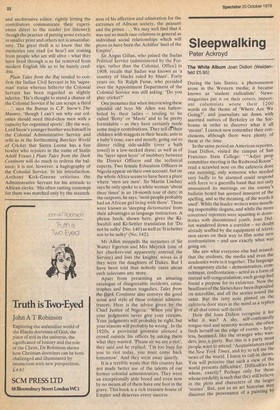Sleepwalking
Peter Ackroyd
The White Album Joan Didion (Weidenfeld £5.95) During the late Sixties, a phenomenon arose in the Western media; it became known as 'student radicalism'. Newsmagazines put it on their covers, important columnists wrote their 1200 words on the theme of 'Where Are We Going?', and journalists sat down with assorted natives of Berkeley or the Sorbonne in order to discover what it all 'meant'. I cannot now remember their conclusions, although there were plenty of them at the time.
In the same period an American reporter, Joan Didion, visited the campus of San Francisco State College: "Adjei prop committee meeting in the Redwood Room" read a scrawled note on the cafeteria door one morning; only someone who needed very badly to be alarmed could respond with force to a guerrilla band that not only announced its meetings on the enemy's bulletin board but seemed innocent of the spelling, and so the meaning, of the words it used'. While the leader-writers were mouthing responsible slogans, and while the more concerned reporters were squatting in dormitories with discontented youth, Joan Didion wandered down a corridor — no doubt already scuffed by the equipment of television crews on their way to film some new confrontation — and saw exactly what was going on. She saw what everyone else had missed: that the students, the media and even the academics were in it together. The language of temporary cliché — demonstration, commitment, confrontation — acted as a form of mutual self-congratulation; each group had found a purpose for its existence. Now the headlines of the Sixties have been deposited on microfilm, and all the stories sound the same. But the tatty note pinned on the cafeteria door stays in the mind as a replica of all that comic self-deceit. How did Joan Didion recognise it for what it was? A shy, self-confessedly tongue-tied and neurotic woman, she often finds herself on the edge of events — helpless, bemused, like the stranger who wanders into a party. But this is a party most people want to attend: 'Acquaintances read the New York Times, and try to tell me the news of the world. I listen to call-in shows. You will perceive that such a view of the world presents difficulties'. Difficulties for whom, exactly? Perhaps only for those whose credulity is such that they still believe in the plots and characters of the larger 'stories'. But, just as an art historian may discover the provenance of a painting by peering at its left-hand corner rather than its theme, Joan Didion observes the events on the margin of those stories, the odd doodlings and scratchings which the rest of us make there. She attends to the way people speak when they have nothing to say, to the way public figures use gestures when they think themselves unobserved, to the clichés which rise like gas within public discourse. Here is Nancy Reagan, wife of the then Governor of California, being asked to perform her domestic routines in front of a television camera: The television newsman suggested that we watch Nancy Reagan pick flowers in the garden. 'That's something you might ordinarily do, isn't it?' he asked. 'Indeed it is,' Nancy Reagan said with spirit. Nancy Reagan says almost everything with spirit, perhaps because she was once an actress and has the beginning actress's habit of investing even the most casual lines with a good deal more dramatic emphasis than is ordinarily called for on a Tuesday morning on 45th Street in Sacramento. 'Actually,' she added then, as if about to disclose a delightful surprise, 'actually, I really do need flowers.' She smiled at each of us, and each of us smiled back. We had all been smiling quite a bit that morning. . , 'Fine,' the newsman said. 'Just fine. Now I'll ask a question, and if you could be just nipping a bud as you answer it. . ."Nipping a bud,' Nancy Reagan repeated, taking her place in front of the rhododendron bush. 'Let's have a dry run,' the cameraman said. The newsman looked at him. 'In other words, by a dry run, you mean you want her to fake nipping the bud.' Fake the nip, yeah,' the cameraman said. 'Fake the nip'.
It might be said that Joan Didion is, simply, susceptible to 'tone' and 'atmosphere': she is, after,all, both a woman and a Californian. But she's doing something else, too; she is reading the sub-text of the newspapers and magazines we hold in our hands, counting the colour lines on the television screen and discovering that they add up to an odd number. If you can 'fake a nip', you can fake everything else. The world is exotic, random and uncaring: there are no stories left to tell.
This is anarchic reporting, which is the best kind, from a writer who is often 'a sleepwalker, moving through the world unconscious of the moment's high issues, oblivious to its data.' The sleepwalker is always difficult to impress, and Joan Didion is not seduced by the packaged offerings of politics there are some astute pieces in this collection on Governor Brown and Eldridge Cleaver — or by the ideological fanfare which greets each new movement and cultural 'figure'. Perhaps it's important to note here that Joan Didion j,s also a novelist, since the two activities are closely aligned. Bad journalism and bad fiction share a preoccupation with cliché and with sentiment, with telling us what we want to hear. Good journalism and good fiction explore the distinctions between word and meaning, between public gesture and private feeling, between the accepted image of the world and the world itself. Mrs Thatcher is incensed over public expenditure, making her 'cuts', while Nancy Reagan is forever faking the nip. Somewhere else, the people who have no stories to tell are listening to call-in shows.







































 Previous page
Previous page